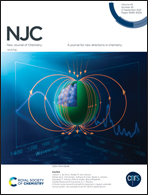The first PdO nanoparticle catalyzed one pot synthesis of propargylamine through A3-coupling of an aldehyde, alkyne and amine†
Abstract
Palladium(II) oxide (PdO) nanoparticles (Nps) were prepared by an environmentally benign hydrothermal method with a new capping agent quercetin. The nanoparticles were characterized using FT-IR, powder XRD, TG-DTA, SEM, EDS, HR-TEM, SAED and surface area analysis (BET) to reveal the formation, crystalline structure, thermal stability, morphology, elemental composition, size, crystalline nature and surface nature, respectively. Quercetin acted well as a capping agent and could yield PdO nanoparticles with a 10–15 nm size. For the first time nanosize PdO was employed as a heterogeneous catalyst for the preparation of therapeutically important propargylamines through A3 coupling reactions. A very small amount of catalyst (10 mg) was enough to complete the reaction. The isolated yields of the products were satisfying and the proposed catalyst could catalyze the reaction in the presence of a wide range of reactants. The turn over number (TON) was calculated to be high with a value of 10 625 h−1 and the turn over frequency (TOF) was also found to be excellent. The formation of propargylamines was confirmed by GC-MS analysis. The PdO catalyst was recyclable and reusable for 7 successive catalytic cycles without a significant loss in yield.



 Please wait while we load your content...
Please wait while we load your content...